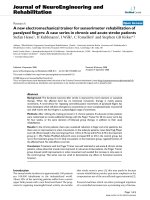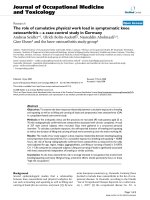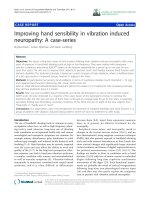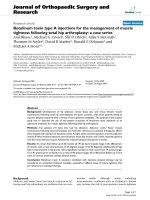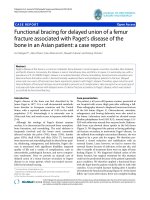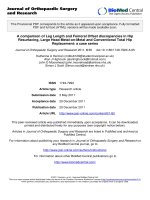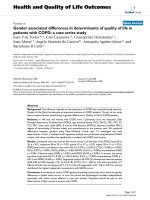Medullary unidentified bright objects in Neurofibromatosis type 1: A case series
Bạn đang xem bản rút gọn của tài liệu. Xem và tải ngay bản đầy đủ của tài liệu tại đây (1.29 MB, 5 trang )
D’Amico et al. BMC Pediatrics (2018) 18:91
/>
CASE REPORT
Open Access
Medullary unidentified bright objects in
Neurofibromatosis type 1: a case series
Alessandra D’Amico1, Federica Mazio1, Lorenzo Ugga1, Renato Cuocolo1,5* , Mario Cirillo2, Claudia Santoro3,
Silverio Perrotta3, Daniela Melis4 and Arturo Brunetti1
Abstract
Background: In Neurofibromatosis type 1, cerebral Unidentified Bright Objects are a well-known benign entity that
has been extensively reported in the literature. In our case series, we wish to focus on a further possible location of
such lesions, the spinal cord, which we have defined as medullary Unidentified Bright Objects. These have been, to
our knowledge, scarcely described in previous works.
Case presentation: We report the cases of 7 patients with medullary Unidentified Bright Objects in Neurofibromatosis
type 1 that we have followed for up to 9 years in our Regional Referral Center for Neurofibromatosis. In all of our
patients, these lesions were completely asymptomatic and reported on Magnetic Resonance exams the patients
underwent for other clinical indications.
Conclusions: The aim of our work is to increase awareness of the possibility of medullary Unidentified Bright
Objects in Neurofibromatosis type 1 patients, which can simulate neoplastic lesions, suggesting a more conservative
approach in these cases.
Keywords: Neurofibromatosis I, Unidentified bright objects, Spine, Magnetic resonance imaging, T2-hyperintense
lesions
Background
Neurofibromatosis type 1 (NF1) is a rare (prevalence of
1 in 2700 newborns) autosomal dominant genetic disorder [1]. It is diagnosed on the basis of clinical criteria
such as the presence of cutaneous spots (café-au-lait),
freckling in the axillary or inguinal regions, neurofibromas (plexiform or otherwise), Lisch nodules, optic pilocityc astrocytoma, sphenoid wing hypoplasia or aplasia,
long bone dysplasia and/ or pseudoarthrosis, and a positive family history (NIH criteria). On Magnetic Resonance (MR), NF1 presents a wide spectrum of alterations
which involve both the white and gray matter in the
whole CNS [2–5]. Spinal neoplasms in NF1 patients can
be both extramedullary (neurofibromas and malignant
peripheral nerve sheath tumors) and intramedullary (astrocytomas, ependymomas and gangliogliomas). We report seven cases of NF1, followed at our referral center,
* Correspondence:
1
Department of Advanced Biomedical Sciences, “Federico II” University, via
Sergio Pansini 5, 80100 Naples, Italy
5
Naples, Italy
Full list of author information is available at the end of the article
who shared intramedullary alterations characterized by
multiple foci of high signal in T2WI similar to unidentified bright objects (UBOs) normally reported in the
brain of NF1 patients [6, 7]. Therefore, medullary UBOs
(mUBOs), although a rare finding, must be considered
in the MRI features of patients with NF1.
Case presentation
Case 1
An 8-year old child with two older brothers presented
with global developmental delays, genu and cubitus valgum, and bilateral clubfoot with a secondary gait disturbance. He was diagnosed with NF1, presenting with
more than six café-au-lait spots (> 5 mm), inguinal and
axillary freckling, one large hairy patch on the hand and
a vascular malformation on the right leg. The neurological exam was negative. He underwent an X-ray exam
of the spine, because of a mild scoliosis, showing scalloping of the posterior wall of T6-T9 vertebral bodies for
which we performed an MR exam of the spine. The MR
scan showed three intramedullary hyperintense lesions
© The Author(s). 2018 Open Access This article is distributed under the terms of the Creative Commons Attribution 4.0
International License ( which permits unrestricted use, distribution, and
reproduction in any medium, provided you give appropriate credit to the original author(s) and the source, provide a link to
the Creative Commons license, and indicate if changes were made. The Creative Commons Public Domain Dedication waiver
( applies to the data made available in this article, unless otherwise stated.
D’Amico et al. BMC Pediatrics (2018) 18:91
Page 2 of 5
on T2WI localized in the cervical and thoracic tracts.
The largest of these lesions was localized in the cervical
tract (C1-C6) and presented a tumor-like appearance
and was initially diagnosed as a low-grade glial neoplasm. Since the patient didn’t present any new symptoms at the time of the exam, a wait-and-see approach
was chosen. Three months later, a follow-up MR exam
of the spine was performed, showing partial spontaneous
regression of the cervical spine lesion and a stability of
the two other T2WI-hyperintense spinal lesions. On the
subsequent MR follow-up exams done annually for three
years and then biannually for 6 more years, the cervical
lesion showed further spontaneous regression and then
was unchanged through the end of the studies (Fig. 1).
All of the MR exams included post-contrast T1WI, and
none of the lesions ever showed enhancement. In the
light of these observations and evidence of clinical stability, the initial hypothesis of a low-grade glial neoplasm
was abandoned and the lesions were reclassified as medullary UBOs.
Case 2
This patient was a 12-year-old female with normal development and growth. She was the only child of a
healthy couple. At the age of five, she presented with
dysphagia, ataxia, typical cafè-au-lait spots and freckles,
thus a clinical diagnosis of NF1 was made. The subsequent brain MR exam showed multiple cerebral and
brainstem T2WI-hyperintense, non-enhancing lesions,
which were diagnosed as UBOs, a diffuse fornix thickening, brainstem enlargement and a unilateral nonenhancing optic nerve glioma. An additional nodular lesion, which presented enhancement on post-contrast
T1WI, was found in the right cerebellar hemisphere and
was identified as a pilocytic astrocytoma. Additional
exams, including ophthalmological and endocrinological
essays revealed no further abnormalities.
The posterior fossa neoplasm showed clinical and
radiological progression at further examinations and the
a
b
c
patient underwent surgical removal of the lesion at the
age of nine, with an improvement of the dysphagia and
ataxia. She then developed a painful dorsal scoliosis for
which X-rays of the spine were performed showing only a
schisis of the posterior arch of S1, leading to a spinal MR
to exclude the presence of neurofibromas. We found multiple small intramedullary lesions which were hyperintense
on T2WI, had blurred margins, located mostly in the central medullary region and in the cervical spine, some of
which presented a tumor-like appearance. None of these
lesions showed enhancement on post-contrast T1WI.
After a two-year MR follow-up, all of the lesions remained
unchanged and were diagnosed as medullary UBOs.
Case 3
A 28-year-old female with normal development and
growth presented for care. At the age of twelve she was
diagnosed with NF1, inherited from her father, and was
noted to have lumbar scoliosis associated with lower
limb length asymmetry, Lisch nodules, multiple cutaneous neurofibromas, cutaneous angiomas and freckles.
The neurological exam was negative. A brain MR examination revealed bilateral pallidal UBOs.
She developed a painful dorsal scoliosis for which she
underwent a spinal MR exam showing three T2WI and
T1WI-hyperintense spinal lesions localized in the thoracic spine with a tumor-like appearance. None of these
lesions showed enhancement on post-contrast T1WI.
During the 9-year MR follow up, these lesions remained
stable without the onset of any new neurological symptoms. Therefore, they were identified as medullary
UBOs (Fig. 2).
Case 4
A male patient who had a positive family history for
NF1 (father) was evaluated. He was 14 years old at the
time of the first exam in our institution. He presented
with cutaneous neurofibromas, macrocephaly, and short
stature. In addition, a bilateral optic nerve pallor was
d
e
Fig. 1 Patient number 1. Sagittal Turbo Spin-Echo T2-w sequences: a large intramedullary hyperintense lesion (C1-C6) at the time of diagnosis (a),
showing regression at 1 (b) and 2-year (c) follow-up, and stability after 3 (d) and 5 years (e). Other smaller lesions with similar features are evident
in the D10-D11 (a) region that were less evident in the last control
D’Amico et al. BMC Pediatrics (2018) 18:91
a
Page 3 of 5
b
c
d
Fig. 2 Patient number 3. Sagittal Turbo Spin-Echo PD-w (a), T2-w (b) and Turbo Spin-Echo T1-w, before (c) and after (d) i.v. contrast injection,
sequences: 3 tumor-like dorsal spinal lesions which show high signal on PD, T1 and T2-w images without enhancement on post-contrast
T1w sequences
noted for which he underwent a brain MR, showing
multiple UBOs, non-enhancing bilateral optic gliomas
and a pilocytic astrocytoma of the left thalamus. The
exam also showed a small T2WI-hyperintense spinal lesion at the level of C1. The subsequent spinal MR examination confirmed the isolated cervical tumor-like lesion
on the right side of the cord which showed no enhancement after gadolinium injection and with well-defined
margins (Fig. 3). This lesion also had high signal intensity in ADC maps. Follow up exams in the next two
years showed no significant variation in the characteristics of the aforementioned lesion.
a
b
c
d
Fig. 3 Patient number 4. Sagittal Turbo Spin-Echo T2-w (a), Spin-Echo T1-w (b), axial Turbo Spin-Echo T2-w (c) and axial ADC map (d). A well-defined,
T2-hyperintense, T1-hypointense tumor-like lesion localized on the right side of the bulbo-medullary junction. It presents high signal intensity on the
ADC map due to intramyelinic edema
D’Amico et al. BMC Pediatrics (2018) 18:91
Page 4 of 5
Case 5
An 8-year-old male with no family history of NF1 was
evaluated and found to have normal psychomotor development and growth. He presented typical features of
NF1 and mild back pain for which a spinal MR exam
was performed. It showed four small tumor-like lesions
of the spinal cord which were moderately hyperintense
on T2WI. These lesions were barely visible in sagittal
scans, but axial images better defined the presence and
characteristics of the aforementioned lesions. None of
these lesions showed enhancement on post-contrast
T1WI and they showed no evolution in the follow up
exam one year later.
Case 6
This 11-year-old male patient had no family history for
NF1 but had global development delays and mild congenital hypotonia. At the age of two months he was diagnosed with NF1, presenting with typical cafè-au-lait
spots, macrocephaly and freckles. A brain MR examination, performed at the age of 10, showed a prerolandic pilocytic astrocytoma for which the patient
underwent surgery.
A spinal MR exam was performed because of the onset
of a painful dorsal scoliosis. It showed four tumor-like
lesions of the spinal cord and of the conus medullaris
which were hyperintense on T2WI and showed no enhancement on post-contrast T1WI. A follow up exam
after 6 months showed no variations. The neurological
examination did not reveal any focal deficit.
Case 7
A 7 year-old male patient was diagnosed at the age of
18 months with NF1, presenting typical cafè-au-lait
spots and freckles, without a family history for this pathology. Neuropsycological development and growth were
normal. He underwent the first MR exam at our institution as he presented persistent headache and a reduction
of the visual acuity, showing a low-grade astrocytoma localized in the tegmentum of the midbrain causing a triventricular hydrocephalus. An incidental lesion of the
cervical spine was detected for which a spine MR was
performed. Three tumor-like, T2WI-hyperintense lesions
were detected, none of which showed enhancement on
T1WI after gadolinium injection. All of these were stable
at follow-up MR exams after 12 months.
Discussion
In previous studies, brain UBOs have been variously defined:
hamartomas, altered myelination, or heterotopias [8–10]. In
the only histological analysis of these lesions, vacuoles
(5–100 μm) have been documented in the myelin sheath.
This was correlated to intramyelinic edema. A reduction in
the cellularity of the white matter was seen as well, together
with an increased proliferation of glial cells [11].
More recent studies have confirmed this finding by
using non-invasive MR techniques which showed a modification of the microstructural compartmentalization with
an increase of extracellular-like intracellular water, an indication of intramyelinic edema, in UBOs confirming the
previously mentioned histological findings [12].
In NF1, intramedullary lesions are more frequently
low-grade astrocytomas (15% of patients) [13]. Rare
cases of ependymomas (4 cases) [14] and gangliogliomas
[15, 16] have also been reported in NF1 patients. These
lesions are almost always symptomatic, single, have an
inhomogeneous signal, often enhance in post-contrast
T1WI and usually show progression in follow-up exams.
To our knowledge only one previous report of a medullary lesion in a patient with NF1, analogous to those herein
documented in our patients, has been published as of this
date. The lesion, in line with the knowledge of the time,
was defined as a hamartomatous spinal cord lesion [17].
We report seven additional cases presenting such
lesions localized in different segments of the spine, mainly
in the cervical segment, describing their MR features and
long-term clinical and radiological follow up. In our
experience, patients more frequently had multiple asymptomatic medullary lesions, with a tumor-like appearance,
always hyperintense in T2WI, hypo, iso or slightly hyperintense in T1WI, and were never enhancing in
post-contrast T1WI. At follow up exams they were stable,
except for one patient in which a spontaneous partial regression was documented (Table 1). For these
Table 1 Summary of the patients’ anagraphical data and neuroradiological features
Age
Sex
T1WI
T2WI
CE
Location (n°)
Follow-up (yrs)
Case 1
8
M
Hyperintense
Hyperintense
None
cervical (1), dorsal (2)
Regression (9)
Case 2
12
F
Isointense
Hyperintense
None
cervical (3), dorsal (2)
Stable (2)
Case 3
23
F
Hyperintense
Hyperintense
None
dorsal (3)
Stable (9)
Case 4
14
M
Hypointense
Hyperintense
None
cervical (1)
Stable (2)
Case 5
8
M
Isointense
Hyperintense
None
cervical (2), dorsal (2)
Stable (1)
Case 6
11
M
Isointense
Hyperintense
None
cervical (2), lumbar (2)
Stable (0,5)
Case 7
7
M
Isointense
Hyperintense
None
cervical (3)
Stable (1)
M male, F female, CE contrast enhancement, n° number, yrs. years
D’Amico et al. BMC Pediatrics (2018) 18:91
characteristics, analogous to those of brain UBOs in NF1
patients, we have classified the spinal lesions of our patients as medullary UBOs (mUBOs).
The limitations of our study are the small number of patients and the absence of a histological confirmation of
our diagnosis due to the benign nature of the lesions
which didn’t justify a biopsy especially in relation to their
medullary localization. For these reasons we hope to expand the population for future studies. Even if screening
for mUBOs is not an indication for routine spinal MR
exams, MR studies of the spine may be done in case of
other symptomatic lesions. Knowledge about these benign
mUBOs is critical for the correct interpretation of the images and providing appropriate prognostic information.
Page 5 of 5
Competing interests
The authors declare that they have no competing interests.
Publisher’s Note
Springer Nature remains neutral with regard to jurisdictional claims in
published maps and institutional affiliations.
Author details
1
Department of Advanced Biomedical Sciences, “Federico II” University, via
Sergio Pansini 5, 80100 Naples, Italy. 2Department of Medical, Surgical,
Neurological, Metabolic and Aging Sciences, “Seconda Università degli Studi
di Napoli” University, via Costantinopoli 104, 80100 Naples, Italy. 3Regional
Referral Center for Neurofibromatosis, Department of Woman, Child, General
and Specialistic Surgery, “Seconda Università degli Studi di Napoli” University,
via Costantinopoli 104, 80100 Naples, Italy. 4Department of Translational
Medical Sciences, “Federico II” University, via Sergio Pansini 5, 80100 Naples,
Italy. 5Naples, Italy.
Received: 12 July 2016 Accepted: 19 February 2018
Conclusions
The presence of mUBOs might have been severely
underestimated in the past due to the asymptomatic nature of these lesions. In all our patients the diagnosis
was made incidentally in spinal or brain MR exams they
underwent for concurrent symptomatic conditions
(painful scoliosis, brain lesions). The aim of our work is
to increase awareness of the possibility of mUBOs in
NF1 patients which can simulate neoplastic lesions, suggesting a more conservative approach.
Abbreviations
CNS: Central nervous system; MR: Magnetic resonance; mUBOs: Medullary
unidentified bright objects; NF1: Neurofibromatosis type 1; NIH: National
Institute of health; T1WI: T1-weighted images; T2WI: T2-weighted images;
UBOs: Unidentified bright objects
Acknowledgments
Not applicable.
Funding
The authors received no funding for this research.
Availability of data and materials
The datasets used and/or analyzed during the current study are available
from the corresponding author on reasonable request.
Authors’ contributions
All authors contributed substantially to the publication, in accordance to the
ICMJE guidelines. In particular: ADA and MC are the pediatric neuroradiogists
who reviewed all the MR exams. AB is the supervisor and head of department
that overviewed all the imaging work done for the paper. FM, LU and RC are
the radiology residents who contributed to collect and analyze the data,
research the bibliographic references and contributed to the writing of the
paper. DM and CS are the pediatric neurologists who follow the patients
whose cases we reported. They have collected the clinical history and data
of the patients. SP is the supervisor and the head of the neurological
department where these patients are followed. All authors read and
approved the final manuscript.
Ethics approval and consent to participate
Not applicable.
Consent for publication
The legal guardians of every patient gave consent for the execution of the
MR exam and to publish the information. In the only case regarding an adult
subject, the patient provided the consent herself. Images were all
anonymized prior to inclusion in the paper.
References
1. Evans DG, Howard E, Giblin C, et al. Birth incidence and prevalence of
tumor-prone syndromes: estimates from a UK family genetic register
service. Am J Med Genet. 2010;Part A 152A(2):327–32.
2. Moore BD 3rd, Slopis JM, Jackson EF, et al. Brain volume in children with
neurofibromatosis type 1: relation to neuropsychological status. Neurology.
2000;54(4):914–20.
3. Cutting LE, Koth CW, Burnette CP, et al. Relationship of cognitive functioning,
whole brain volumes, and T2-weighted hyperintensities in neurofibromatosis1. J Child Neurol. 2000;15(3):157–60.
4. Steen RG, Taylor JS, Langston JW, et al. Prospective evaluation of the brain
in asymptomatic children with neurofibromatosis type 1: relationship of
macrocephaly to T1 relaxation changes and structural brain abnormalities.
AJNR Am J Neuroradiol. 2001;22(5):810–7.
5. Greenwood RS, Tupler LA, Whitt JK, et al. Brain morphometry, T2-weighted
hyperintensities, and IQ in children with neurofibromatosis type 1. Arch
Neurol. 2005;62(12):1904–8.
6. Rosenbaum T, Engelbrecht V, Krölls W, et al. MRI abnormalities in
neurofibromatosis type 1 (NF1): a study of men and mice. Brain and
Development. 1999;21(4):268–73.
7. DeBella K, Poskitt K, Szudek J, et al. Use of "unidentified bright objects" on MRI
for diagnosis of neurofibromatosis 1 in children. Neurology. 2000;54(8):1646–51.
8. Braffman BH, Bilaniuk LT, Zimmerman RA. The central nervous system
manifestations of the phakomatoses on MR. Radiol Clin N Am.
1988;26(4):773–800.
9. Smirniotopoulos JG, Murphy FM. The phakomatoses. AJNR Am J Neuroradiol.
1992;13(2):725–46.
10. Bognanno JR, Edwards MK, Lee TA, et al. Cranial MR imaging in
neurofibromatosis. AJR Am J Roentgenol. 1988;151(2):381–8.
11. DiPaolo DP, Zimmerman RA, Rorke LB, et al. Neurofibromatosis type 1:
pathologic substrate of high-signal-intensity foci in the brain. Radiology.
1995;195(3):721–4.
12. Billiet T, Mädler B, D'Arco F, et al. Characterizing the microstructural basis of
"unidentified bright objects" in neurofibromatosis type 1: a combined in
vivo multicomponent T2 relaxation and multi-shell diffusion MRI analysis.
Neuroimage Clin. 2014;4:649–58.
13. Tortori-Donati P, Rossi A. Pediatric Neuroradiology. Brain, Head and Neck,
Spine. Springer 2005;777.
14. Cheng H, Shan M, Feng C, et al. Spinal cord ependymoma associated with
neurofibromatosis 1: case report and review of the literature. J Korean
Neurosurg Soc. 2014;55(1):43–7.
15. Hayashi Y, Nakada M, Mohri M, et al. Ganglioglioma of the thoracolumbar
spinal cord in a patient with neurofibromatosis type 1: a case report and
literature review. Pediatr Neurosurg. 2011;47(3):210–3.
16. Giussani C, Isimbaldi G, Massimino M, et al. Ganglioglioma of the spinal
cord in neurofibromatosis type 1. Pediatr Neurosurg. 2013;49(1):50–4.
17. Katz BH, Quencer RM. Hamartomatous spinal cord lesion in
neurofibromatosis. AJNR Am J Neuroradiol. 1989;10(5 Suppl):S10.


